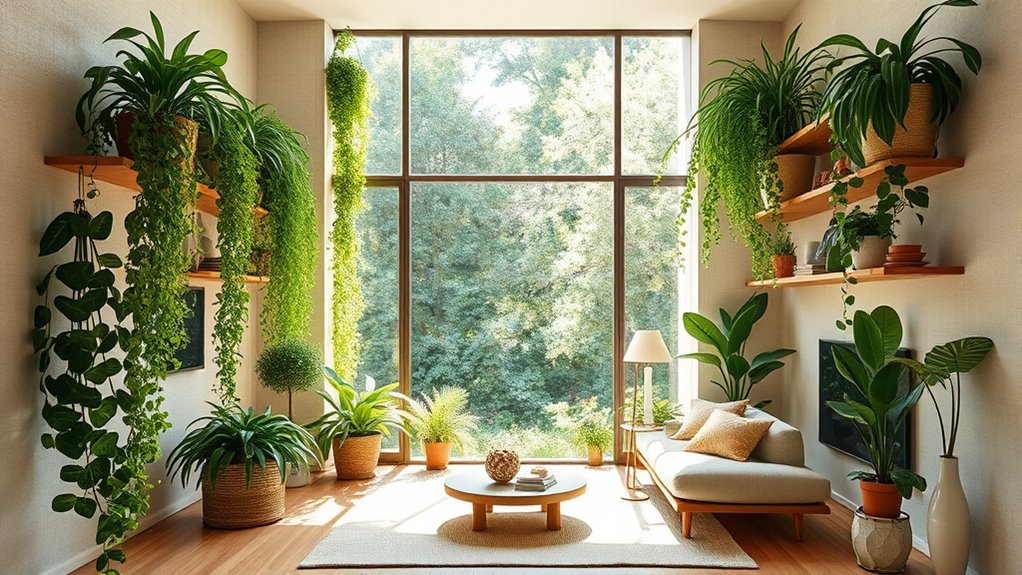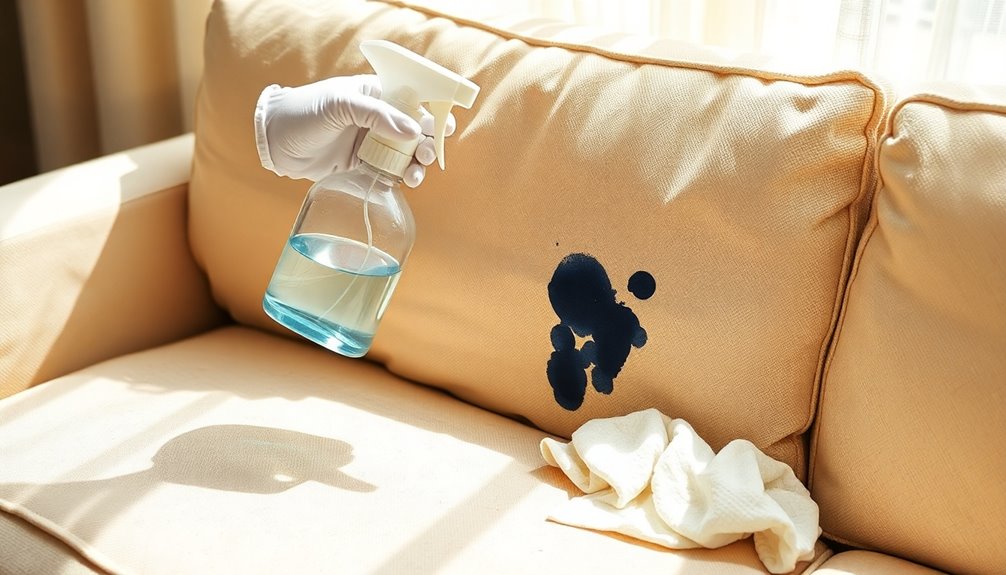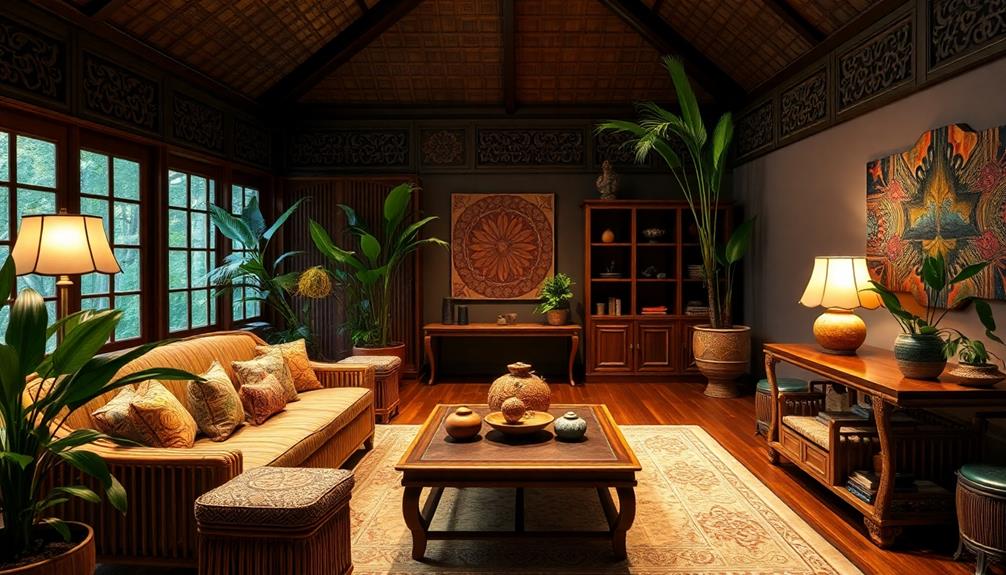To bring biophilic beauty indoors, focus on maximizing natural light with large windows and skylights, and incorporate indoor plants that suit your space and care level. Use organic materials like wood and stone, and add water features or natural shapes to create calming visuals and sounds. Incorporate nature-inspired art and textures to enhance sensory experiences, improve air quality, and create a seamless connection with nature. Keep exploring to discover more ways to transform your space into a natural sanctuary.
Key Takeaways
- Maximize natural light with large windows, skylights, and glass doors to create an open, inviting connection to the outdoors.
- Incorporate indoor plants using creative placements like wall-mounted or hanging planters to enhance greenery and improve air quality.
- Use natural materials such as wood, stone, and woven fibers to add warmth, texture, and authenticity to interior spaces.
- Design with natural shapes, patterns, and earthy color palettes to evoke organic forms and create a calming ambiance.
- Integrate water features and nature-inspired art to foster sensory engagement and deepen the indoor connection to the natural environment.
Embracing Natural Light to Brighten Your Space
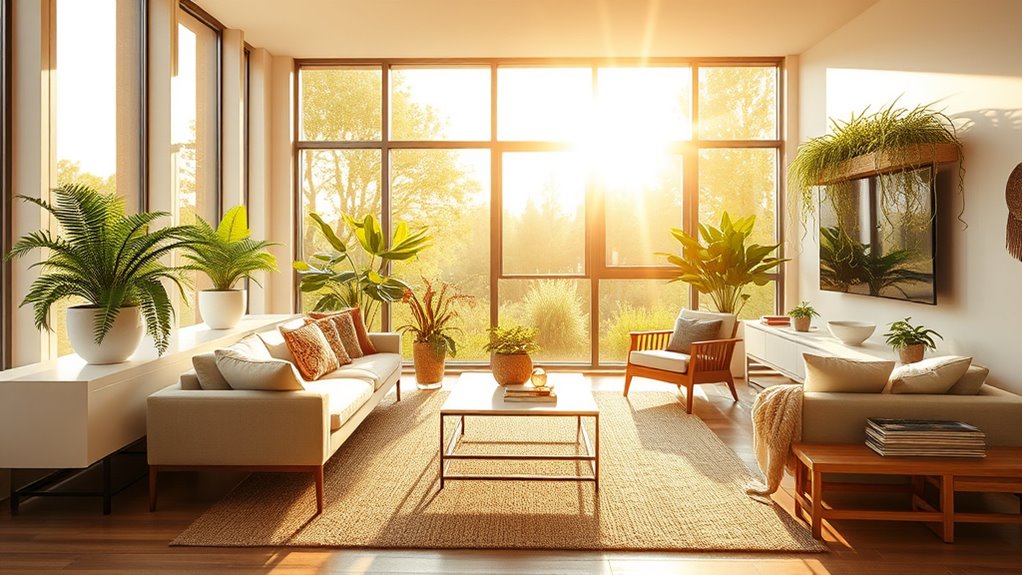
Natural light has the power to transform any space, making it feel more open, inviting, and connected to the outdoors. By maximizing natural light, you reduce your dependence on artificial lighting, supporting sustainable energy use. When designing your space, choose eco-friendly materials like sustainable window frames and light-diffusing glass to enhance brightness naturally. Large windows, skylights, and glass doors allow sunlight to flood in, creating a warm, uplifting atmosphere. Not only does this boost your mood, but it also lowers energy bills and minimizes your carbon footprint. Incorporating eco-conscious choices ensures your home stays environmentally friendly while celebrating natural light’s benefits. With thoughtful placement and eco materials, you turn your space into a bright, sustainable sanctuary that feels alive and connected to nature.
Incorporating Indoor Plants for a Living Touch

Adding indoor plants brings life and freshness to your space, but choosing the right ones is key. Think about where they’ll thrive and how to arrange them creatively for maximum impact. With proper care and maintenance, your plants will stay healthy and continue to enhance your environment. Additionally, understanding the light and watering requirements of your plants can significantly improve their longevity and appearance. For large indoor plants, paying attention to watering techniques such as the soak or spritz methods can help prevent issues like overwatering or dehydration.
Selecting Suitable Plants
Choosing the right indoor plants is essential to creating a vibrant, living space that complements your environment. Start by considering low-maintenance houseplants that thrive with minimal care, perfect for busy lifestyles or beginners. If you enjoy fresh herbs, indoor herb gardening offers functional greenery that adds flavor and aroma to your kitchen. Look for plants like pothos, snake plants, or ZZ plants, which are hardy and forgiving. Assess your space’s light levels and humidity to select plants that will flourish. Avoid plants that require high humidity or direct sunlight if those conditions aren’t available. By choosing suitable plants aligned with your environment and lifestyle, you’ll create a sustainable, beautiful indoor garden that enhances your space’s biophilic appeal. Additionally, understanding your breakup reasons can help you select plants that symbolize growth and renewal, fostering a positive environment for emotional healing. Incorporating beneficial plants into your space can also improve air quality and overall well-being, making your indoor garden both beautiful and health-promoting. To ensure your plants thrive, consider researching best home security systems of 2024 that offer features like smart alerts and remote monitoring, providing peace of mind while you nurture your indoor sanctuary.
Creative Placement Ideas
To truly bring your indoor space to life, consider creative ways to place your plants where they’ll make the biggest impact. An indoor garden isn’t limited to a single corner; mix heights and textures for a dynamic plant arrangement. Use hanging planters to add visual interest or place tall plants next to windows for natural light. Group smaller plants on shelves or tables to create focal points. Incorporate wall-mounted planters or vertical gardens to maximize space and add greenery at eye level. These ideas turn your space into a living artwork, blending functionality with aesthetics. Additionally, selecting the right lighting conditions ensures your plants thrive and enhances their visual appeal. Regularly assessing your space and adjusting placements can maintain a balanced and vibrant environment, embracing a mindful approach to indoor gardening.
Care and Maintenance Tips
Maintaining the beauty of your indoor garden requires regular care and mindful habits. Proper plant care ensures your greenery stays vibrant and healthy. Start with a consistent watering schedule, adjusting based on each plant’s needs and environment. Overwatering can lead to root rot, so check soil moisture before watering.
Here are some tips to keep your plants thriving:
- Observe your plants regularly for signs of stress or pests.
- Adjust watering schedules based on seasonal changes and plant type.
- Use well-draining soil to prevent waterlogging.
- Rotate plants periodically for even light exposure.
- Being aware of plant health monitoring techniques can help you detect early signs of issues and act promptly. Additionally, understanding how tuning techniques influence plant growth can lead to healthier, more resilient indoor gardens. Incorporating AI-driven diagnostics can further optimize your plant care routine by providing personalized insights and recommendations.
Following these simple steps helps you sustain your indoor greenery and enjoy its natural beauty long-term.
Using Organic Materials and Textures in Design
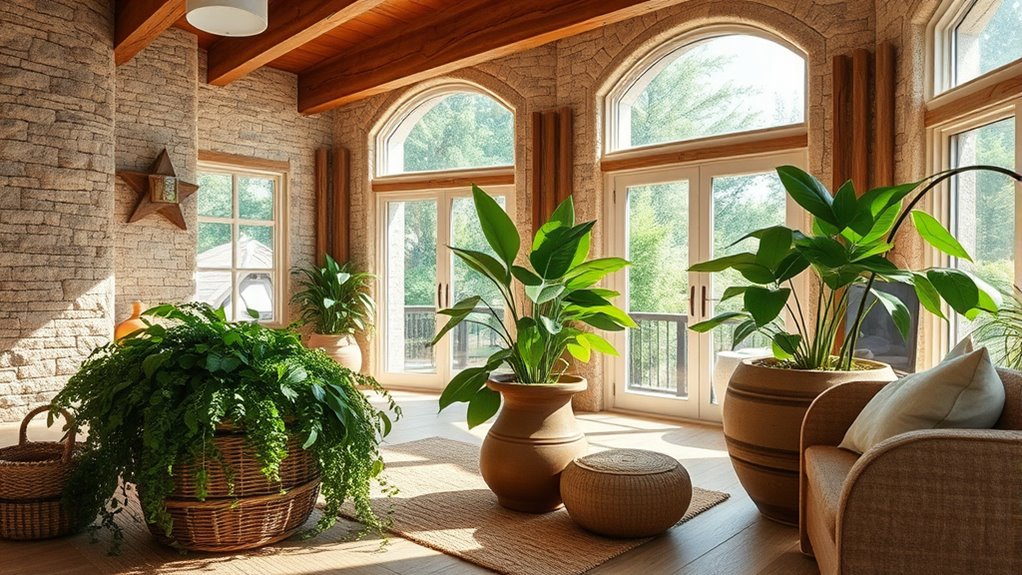
You can create a warm, inviting space by choosing natural materials like wood, stone, and woven fibers. Combining different textures adds depth and tactile interest to your design. Pay attention to how these elements work together to enhance the organic feel of your environment. Incorporating natural materials in your decor not only supports the aesthetic but can also contribute to a healthier indoor atmosphere. Additionally, integrating self-watering plant pots can help maintain consistent moisture levels, promoting healthier plant growth and adding a touch of lush greenery to your space. Emphasizing textural variety can further enrich your overall design by creating visual and tactile contrast.
Natural Material Selection
Choosing organic materials and textures transforms a space into a more authentic and calming environment. When selecting natural materials, focus on sustainable sourcing to reduce environmental impact and assure longevity. Durable materials help your design stand the test of time, maintaining their beauty and function. Consider these options:
- Reclaimed wood – eco-friendly and rich in character, offering excellent material durability.
- Cork – sustainable, soft to the touch, and resilient under everyday use.
- Linen – natural fiber with a calming texture, perfect for upholstery and drapes.
- Bamboo – fast-growing, renewable, and versatile for furniture and accents.
Prioritize sources that guarantee sustainability and durability, creating a space that’s both beautiful and environmentally responsible. Incorporating natural waxes in your decor can also enhance the organic feel and add subtle scent qualities. Additionally, understanding lifestyle and money concepts like investment diversification can help you allocate resources effectively towards sustainable design choices. To ensure your materials remain in optimal condition, consider using appropriate care and maintenance techniques to prolong their lifespan.
Textural Layering Techniques
To create a truly immersive biophilic space, layering different organic textures adds depth and visual interest. Textural layering involves combining a variety of natural materials to enhance tactile contrast, making the space feel richer and more inviting. Use rough and smooth surfaces together—like woven baskets paired with sleek wooden furniture—to stimulate your sense of touch and create visual harmony. Incorporate textiles such as linen, jute, or wool for warmth, and contrast these with stone or ceramic elements for cooler textures. This tactile contrast invites exploration and engagement, drawing you closer to nature. By thoughtfully layering textures, you emphasize organic authenticity, making your space feel alive, vibrant, and uniquely connected to the natural world around you. Texture diversity can further enrich the sensory experience within your design, especially when you incorporate a variety of organic materials to achieve a balanced and harmonious environment. Additionally, incorporating electric bikes or other sustainable energy elements can subtly enhance your eco-conscious design.
Creating Views of Nature Through Windows and Openings
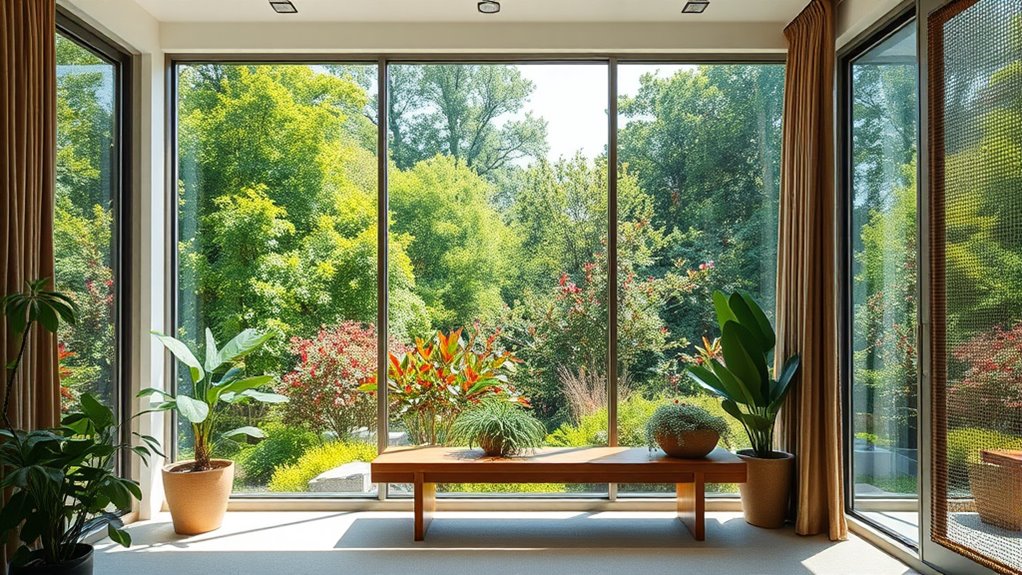
Creating views of nature through windows and openings transforms indoor spaces into immersive environments that foster well-being and connection. Proper window framing enhances outdoor views, making nature a seamless part of your daily life. To maximize this effect, consider these tips:
Creating seamless indoor-outdoor connections through thoughtful window design enhances well-being and daily immersion in nature.
- Choose large, unobstructed windows to capture expansive outdoor views.
- Opt for window framing that complements your landscape, highlighting focal points like trees or gardens.
- Incorporate multiple openings to create a sense of continuity between indoors and outdoors.
- Use transparent or minimally framed windows to reduce visual barriers, inviting nature inside effortlessly.
Integrating Water Features for a Calming Atmosphere

Integrating water features into your space brings a soothing element that enhances the connection between indoor and outdoor environments. You can incorporate water fountains to create gentle, calming sounds that promote relaxation. Pair them with aquatic plants like water lilies or reeds to add natural beauty and improve water quality. Consider placement carefully—central locations or corners work well for a tranquil focal point. Maintaining a balance between movement and stillness helps sustain a peaceful atmosphere. Additionally, choosing the right water circulation method ensures your water features remain clean and healthy. Here’s a simple guide:
| Water Features | Aquatic Plants |
|---|---|
| Fountains, cascades | Water lilies, reeds |
| Indoor ponds | Lotus, floating plants |
| Bubbling urns | Marginal plants |
| Wall-mounted features | Hardy aquatic grasses |
Being mindful of harmony in design ensures your water features create a truly calming environment.
Utilizing Earth Tones and Natural Color Palettes
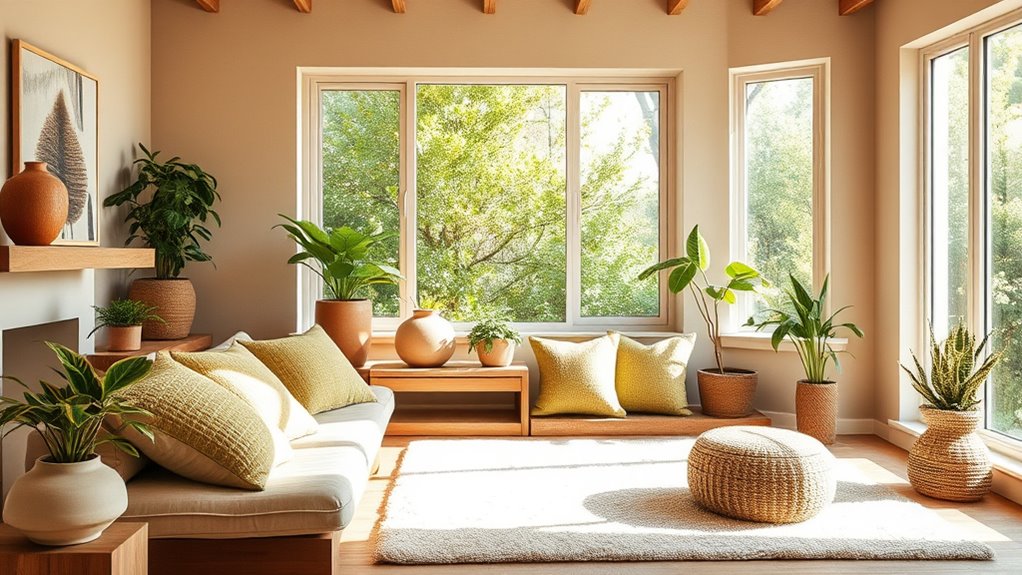
Embracing earth tones and natural color palettes can substantially enhance the sense of tranquility in your space. These colors evoke calmness through their connection to nature and support positive color psychology, reducing stress. When selecting hues, consider shades like warm browns, soft greens, and muted beiges that promote relaxation. Additionally, choosing materials with sustainability in mind guarantees your design remains eco-friendly and durable. Here are four ways to incorporate these palettes effectively:
- Use natural wood finishes to add warmth and texture.
- Incorporate muted greens and browns in wall paint or decor.
- Opt for organic fabrics like linen or hemp in earthy shades.
- Pair colors with sustainable materials to reinforce eco-conscious design.
Designing With Natural Shapes and Patterns
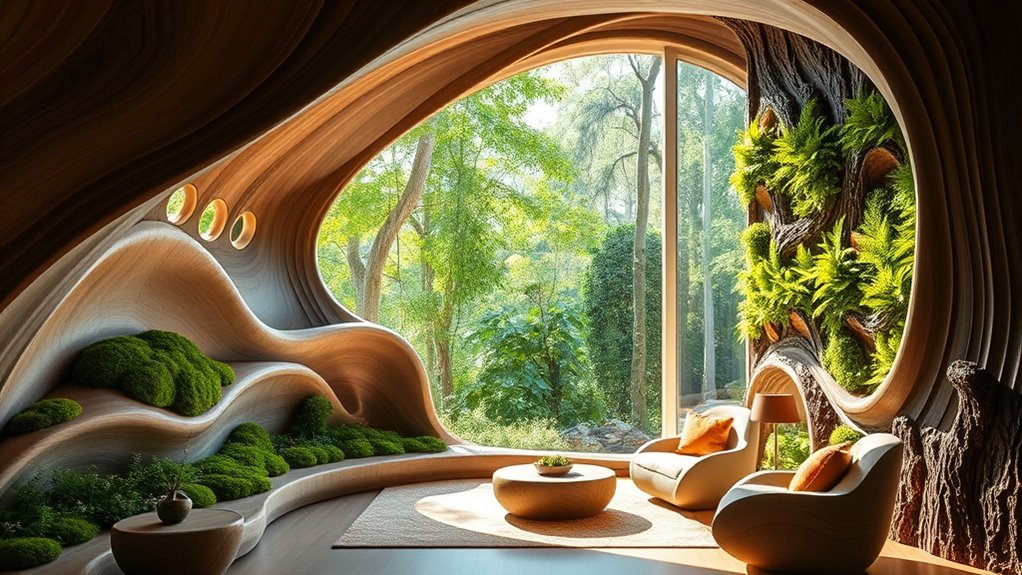
Building on the calming influence of natural colors, incorporating shapes and patterns inspired by nature further enhances a sense of harmony in your space. Use geometric patterns that mimic the natural symmetry found in leaves, shells, or stones to create visual rhythm. Abstract motifs, like swirling lines or organic curves, evoke the fluidity of rivers or wind, making your environment feel alive and dynamic. Mixing and matching these patterns thoughtfully to avoid clutter, maintaining balance and flow. Incorporate natural shapes into furniture, textiles, or decor elements to reinforce a connection with the outdoors. This approach not only stimulates visual interest but also fosters a tranquil atmosphere, making your space feel more inviting and rooted in nature’s inherent beauty. natural shapes can be integrated into various design elements to deepen your connection with the outdoors, especially when considering the relationships that influence our emotional well-being. Utilizing natural patterns like fractals and repetitive motifs can further enhance the organic feel of your interior design.
Bringing in Biophilic Art and Imagery
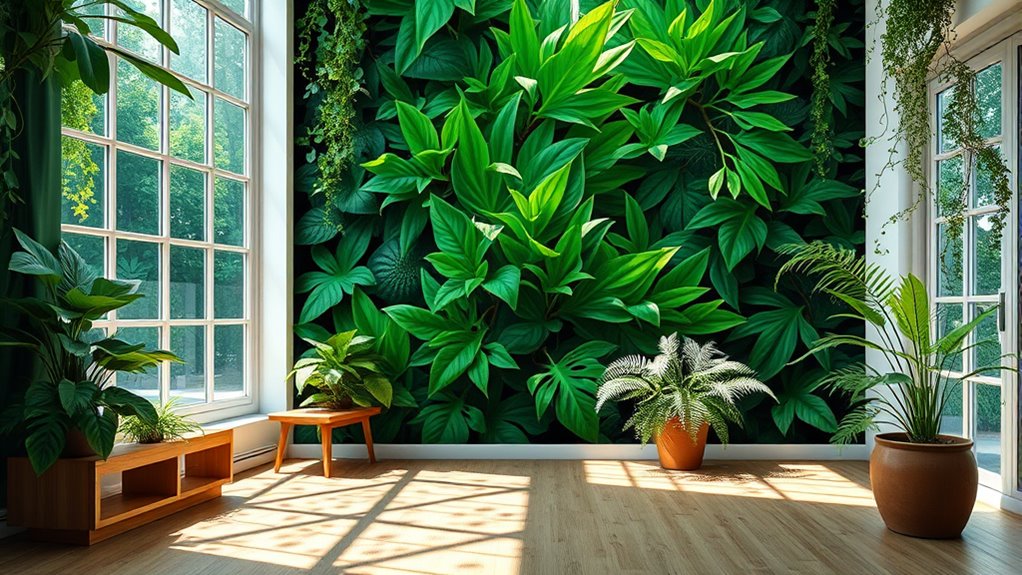
Incorporating biophilic art and imagery into your space instantly deepens your connection to nature, making your environment more vibrant and calming. You can achieve this with several impactful choices:
Bringing biophilic art into your space enhances tranquility and reconnects you with nature’s beauty.
- Use nature-inspired murals that cover entire walls, creating an immersive natural environment.
- Display botanical photography featuring lush plants and serene landscapes to evoke tranquility.
- Hang framed prints of detailed botanical illustrations to add elegance and a touch of nature’s intricacy.
- Incorporate digital screens displaying changing nature scenes, blending art and technology seamlessly.
These elements bring organic beauty into your space, fostering relaxation and inspiration. By thoughtfully selecting nature-inspired murals and botanical imagery, you create a calming haven that visually reconnects you with the outdoors.
Enhancing Air Quality With Greenery and Ventilation
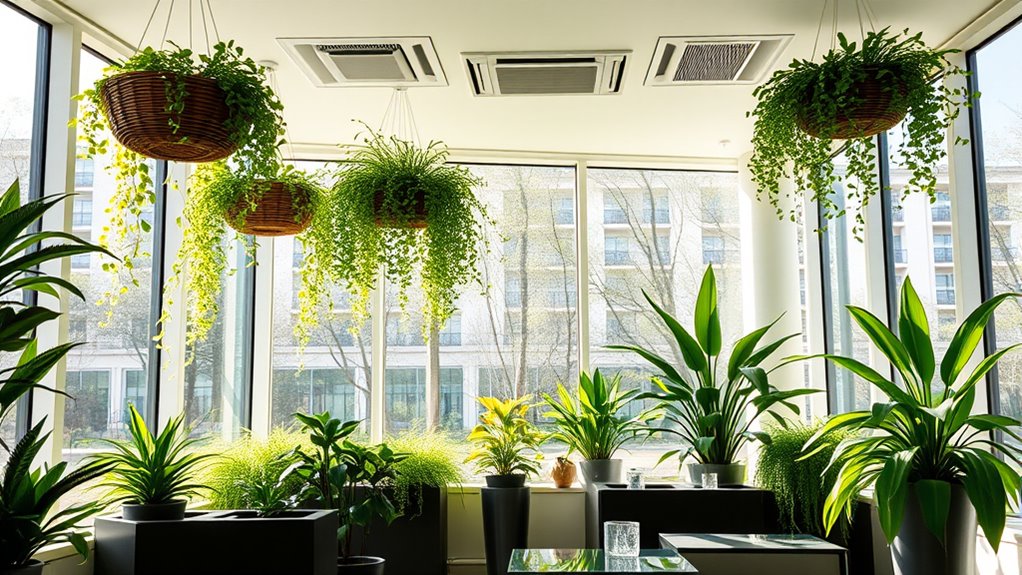
Integrating greenery and proper ventilation into your space particularly improves indoor air quality, making it healthier and more invigorating. Plants like snake plants and pothos naturally purify the air through air purification, removing toxins and increasing oxygen levels. Simultaneously, good airflow reduces indoor pollutants and stale odors. To optimize this, consider adding scent diffusers with natural essential oils, which enhance freshness without overwhelming your senses. Proper ventilation systems, like exhaust fans or open windows, ensure continuous air exchange.
| Greenery Benefits | Ventilation Improvements |
|---|---|
| Natural air purification | Eliminates indoor pollutants |
| Adds oxygen and humidity | Refreshes indoor environment |
| Reduces VOCs and odors | Prevents mold and stale air |
Crafting Multi-Sensory Experiences With Nature-Inspired Elements
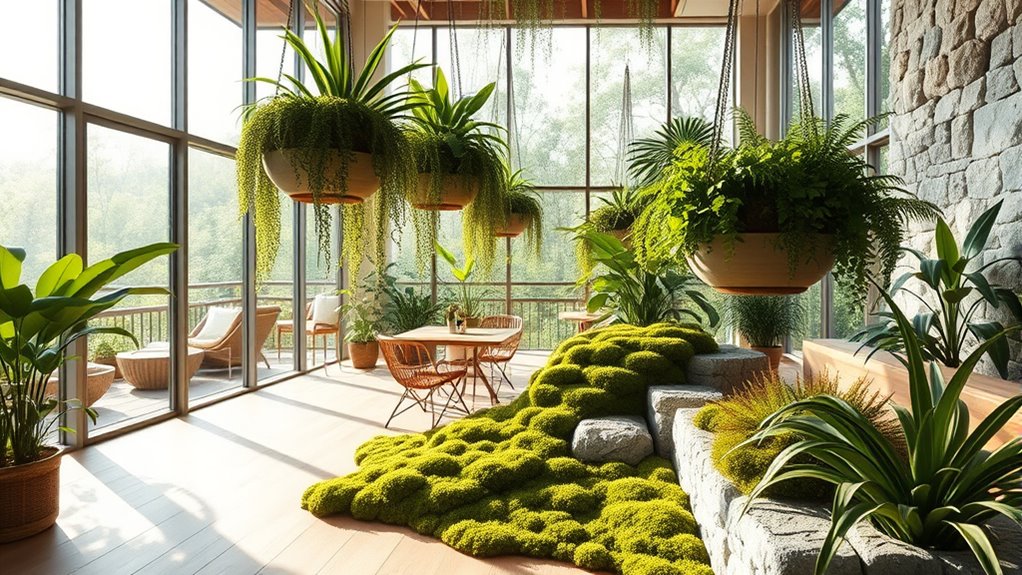
You can create immersive spaces by combining textures and tactile elements that invite touch and exploration. Incorporating natural scents enhances the atmosphere, making the environment feel more alive and calming. Adding visual displays of nature amplifies these experiences, engaging multiple senses and strengthening your connection to the natural world.
Textures and Tactile Elements
Textures and tactile elements bring a tangible connection to nature’s beauty, engaging your senses and enriching your environment. Incorporate textured wall coverings to add depth and a natural feel to your space. Tactile fabric choices like linen, burlap, or woven textiles invite touch and warmth. To enhance sensory experiences, consider these options:
- Use textured wall coverings inspired by bark or stone for visual and tactile interest.
- Select tactile fabrics with varied weaves and natural fibers for furniture and accessories.
- Incorporate woven baskets and mats to add texture and a handcrafted touch.
- Mix smooth and rough surfaces to create contrast, encouraging exploration through touch.
These elements foster a multi-sensory environment that keeps nature’s tactile beauty close to your daily life.
Aromatic Natural Scents
Building on the tactile richness of natural textures, incorporating aromatic scents enhances the multi-sensory experience by engaging your sense of smell. You can achieve this by using essential oil blends that evoke calming, invigorating, or grounding effects. Diffusing lavender or eucalyptus creates a soothing atmosphere, while citrus or peppermint energizes your space. Herbal infusions, like rosemary or thyme, add subtle, natural fragrances that connect you to garden-like serenity. Incorporate scented candles or reed diffusers with carefully curated blends to fill your environment with nature-inspired aromas. These scents not only elevate your mood but also reinforce your connection to the outdoors, making your indoor space a sanctuary that nurtures all your senses.
Visual Nature Displays
Incorporating visual elements inspired by nature transforms your space into a living, breathing display of the outdoors. You can create stunning decorative nature displays that engage the senses and elevate your environment. To start, focus on visual plant arrangements—group different textures and sizes for a dynamic look. Consider adding:
- Vibrant floral displays that mimic wildflower meadows
- Vertical gardens or green walls for a lush backdrop
- Natural-colored sculptures or driftwood accents
- Layered arrangements of stones and foliage for depth
These elements not only beautify your space but also foster a calming, nature-inspired ambiance. By thoughtfully combining these visual plant arrangements and decorative nature displays, you craft multi-sensory experiences that bring the outdoors inside with style and purpose.
Frequently Asked Questions
How Can I Incorporate Biophilic Design in Small Urban Apartments?
To incorporate biophilic design in small urban apartments, focus on maximizing natural lighting by choosing light-colored walls and placing windows strategically. Add vertical gardening to save space and bring greenery closer to you. Use plant shelves or wall-mounted planters to create a lush, natural feel without crowding your space. These elements boost your connection to nature while making your apartment feel larger and more inviting.
What Are Cost-Effective Ways to Bring Nature Indoors?
To bring nature indoors on a budget, you can try simple DIY projects like creating your own plant hangers or vertical gardens using recycled materials. Incorporate budget decor such as affordable potted plants, botanical prints, or natural textiles. These easy, cost-effective ideas add a touch of nature to your space without breaking the bank, making your home feel more vibrant and revitalizing.
How Does Biophilic Design Impact Mental Health and Well-Being?
You might find that biophilic design considerably boosts your mental health and well-being. It helps reduce stress by creating calming environments and enhances cognitive functions through natural elements that stimulate your senses. Incorporating plants, natural light, and organic textures makes your space more inviting and restorative. As a result, you feel more relaxed, focused, and energized, leading to better overall mental health and a more positive daily experience.
Can Biophilic Elements Be Integrated Into Existing Home Structures Easily?
You can integrate biophilic elements into your existing home, but renovation challenges and structural modifications may arise. You might need to reinforce walls for large plant installations or install new windows to maximize natural light. While some updates are straightforward, others require careful planning and professional assistance. By working with experienced designers, you can seamlessly incorporate features like indoor gardens or natural materials without compromising your home’s integrity.
What Maintenance Is Required for Indoor Plants and Water Features?
You’ll need to regularly care for indoor plants and water features. For plants, prune them to promote healthy growth and remove dead leaves. Water features require water filtration to keep the water clean and prevent algae buildup. Check water levels frequently and clean filters as needed. Consistent maintenance guarantees your indoor greenery remains vibrant and your water features stay clear, creating a fresh, natural atmosphere in your home.
Conclusion
By thoughtfully weaving nature into your space, you create a gentle sanctuary that nurtures your spirit and soothes your soul. Embracing these biophilic touches transforms your environment into a calming refuge, inviting peace and renewal. With each natural element, you foster a connection that quietly uplifts your daily life, reminding you of the simple beauty and serenity found in the world outside. In doing so, you cultivate a space where both heart and home can flourish.
